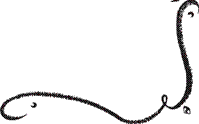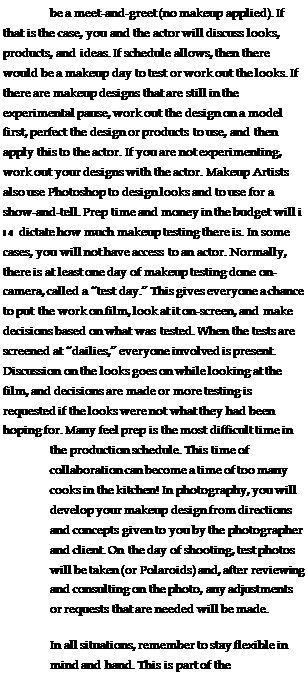Makeup accessorizes the character’s look, mood, and style. We put the finishing touch on the actor’s exterior to match the interior performance and to bring the character to life. This enables the actor to focus on the performance and not the look, and to become the character. Many times you will feel the actor start to transform before your eyes as the makeup application progresses. They are looking into the mirror and seeing the physical appearance matching the interior of their performance/character, and their body language begins to change. At this moment, both actor and artist know the makeup design (and application) is working. You know you have been successful in developing the character.
In film, every makeup begins with the text of the script. Makeup is one of several languages used to elaborate and illustrate text. Based on the text, we make all sorts of decisions: the character’s physical wellbeing, social and financial status, level and condition of vanity, and inclination to spend time in front of the mirror. At the point the actor or actress enters our lives, his or her analysis of the same textual information meets our own. Add to this their personal needs, physical condition, areas of insecurity, and physical strengths, and we are nearly ready to put brush to skin.
—Richard Dean
We explore, examine, research, discuss, collaborate, and meet with the Director, Actor, Costume Designer, Production Designer, Cinematographer, and the
Producers. From our breakdown of the script, design meetings, production meetings, and sidebar meetings, we begin to test the looks. This is the prep period of the schedule: the weeks or days (for prosthetics, the prep time is much longer) before filming begins, for both film and TV. Stage has its own prep or rehearsal period, where designs and makeup are worked out in dress rehearsals onstage with lighting. There is the same collaboration with Director, Costume Designer, and Lighting Designer—and, you hope, a chance to see your makeup “from the house” with the lighting plot or design. This is the time to see your performers from the seats in the audience (“from the house”), usually viewing from orchestra seats, midway back, to judge how your makeup is reading to the audience. It is generally a standard in theatre or opera to work from this vantage point of “middle of the house.” With each theatre being a different size and capacity, you adjust your work accordingly. If you work for the back reaches of the house, the makeup will be too heavy for the seats in the front rows. If you work for the front of the house, your makeup will not be seen by anyone seated past the first few rows. So you split the difference and go for midway.
Adjustments are also made for HD filming of stage productions and live broadcasts.
This has altered the products and style of makeup used for stage, and has lessened the theatricality of the makeup.
For photograhy, the design is based on conversations with the Photographer, Art Director, and client. There could be several days to create a design or look, or just one day. It is a project-per-project situation,
![]()

![]()

 with amount of time, research, and designing per job varying greatly—from exotic, very stylized fashion to natural, to designing the makeup for a runway collection.
with amount of time, research, and designing per job varying greatly—from exotic, very stylized fashion to natural, to designing the makeup for a runway collection.
There is a lot to think about in all areas of makeup, starting with what medium is being used? What is the look (style) of the project? Is there a color palette that all departments are working with? Who are the characters (and their background)? What is the movement of the story? Who is the client? Is it an editorial shoot or advertising? Where are the shooting locations? Environmental factors; continuity issues. What does the Director want? What does the actor want. Is there an arc to the story that affects the makeup movement? What research needs to be done to create realism? What creative influences do you want to use: European fashion magazines, art books, American fashion, street or local fashion, or museums? Is it fantasy or real life? What is the inspiration?
Inspiration for design can come from just about any source. It’s all around you.
|
|
PRO TIP
People-watching is a great source of inspiration. Ride the subways and public transportation; visit different neighborhoods; people-watch at the airport; go to clubs and social events that appeal to the specific types of characters that you are researching. Keep current with beauty trends and fashion; think internationally
with sources from Milan, Paris, London, New York. Art books and photography books, and old Life and Time magazines, and old catalogues from the time period (Sears, Roebuck) are great sources. Walking down the street you see the most interesting makeup choices and characters that you never would have imagined. Inspiration is all around you.
There is movement to makeup in film. Our work is consistently changing with the mood or emotion of the character, the situations, and the environment of filming. It can be extremely subtle or very obvious. Attention to detail brings life to the look and believability. The more believable, the less focus on the fact that it is makeup.
Read through the text several times, making notes and breaking down the script before meeting with the Director. Script breaks are done by all departments, and you must compare and defer to the Script Supervisor’s version as the final word. The Script Supervisor will provide a breakdown to all department heads. Recommend reading for script breakdown “Costuming for Film: The Art and The Craft” by Holly Cole and Kristin Burke.
![]() After meeting with the Director, meet with the other departments: Costume Designer, Production Designer, Cinematographer. This is the time of discovery and aesthetics decisions. It is also a time for research. Once you feel you have done your due diligence, talk to the AD (Assistant Director) about meeting with the actors. The AD handles all scheduling. Your first meeting could just
After meeting with the Director, meet with the other departments: Costume Designer, Production Designer, Cinematographer. This is the time of discovery and aesthetics decisions. It is also a time for research. Once you feel you have done your due diligence, talk to the AD (Assistant Director) about meeting with the actors. The AD handles all scheduling. Your first meeting could just

![]() process of problem-solving and collaboration that go into designing looks and characters. There will be times when you will be asked to change or correct something. Do not be put off, but understand that you will not always get it right the first time. Ideally, you will have the opportunity to start out with small projects, independent films, industrial projects, and small print jobs to hone your skills, creativity, and intuition. These small projects help to develop and perfect your problem-solving ability in design. Knowing how to achieve a look with very little money or resources, or how to create a look when the environmental issues at hand will cause problems (like humidity) is an asset. You will struggle to achieve and maintain your makeup if you do not look at the whole picture. It is foolish to not consider all elements to each design situation.
process of problem-solving and collaboration that go into designing looks and characters. There will be times when you will be asked to change or correct something. Do not be put off, but understand that you will not always get it right the first time. Ideally, you will have the opportunity to start out with small projects, independent films, industrial projects, and small print jobs to hone your skills, creativity, and intuition. These small projects help to develop and perfect your problem-solving ability in design. Knowing how to achieve a look with very little money or resources, or how to create a look when the environmental issues at hand will cause problems (like humidity) is an asset. You will struggle to achieve and maintain your makeup if you do not look at the whole picture. It is foolish to not consider all elements to each design situation.
You now have some idea what the Makeup Department Head or Makeup Designer goes though. In the beginning of your career, you will not be privy to all the meetings, discussions, and decisions regarding design. The bigger the budget and show, the more this is true. This is why we remind you often to follow instructions given by those members of the department that are supervising the makeup crew. This is true for all mediums; so much has gone into the design and choices for a project long before you arrive for your first day of work. If you are a daily hire, the larger the show the more likely it is that you will have very little interaction with the HOD (Head of Department). The HOD will be relying on their crew to instruct and manage a large
staff. There is a temptation in a large work situation to “grand stand,” or stand-out from the group. Resist the urge! When you are new and wanting to impress, all you have to do is your job! The HOD might not have the time to chat with you, but they know who is getting the work done. This is what will impress those you work for; doing the makeup asked for, paying attention, being professional on and off set, and not trying to over-step your position to get attention.
